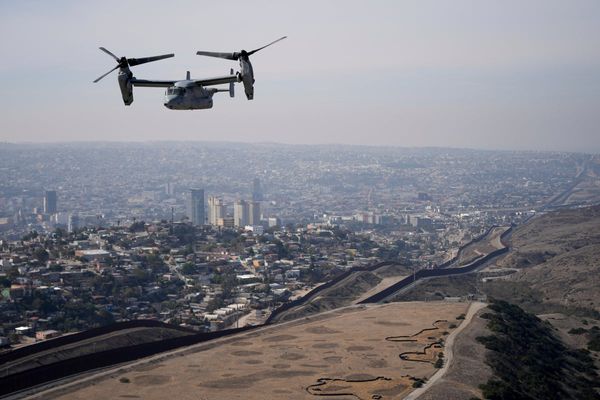
The land west of Melbourne is flat and productive. No mountain range hems in the city’s growth. Instead, the border is built by planning policy, a promise set down in the 1970s to maintain 12 “green wedges” to serve as the city’s lungs and its food bowl. Two of those green wedge zones – Western Plains South and Werribee South – sit just outside the urban growth boundary, a dotted line on the planning maps that crosses the M1 freeway just outside Werribee. They contain some of the last of Victoria’s critically endangered grasslands and are intended to be off limits to major development.
So it was a shock to locals to discover the area was set to become home to a large freight hub.
Merryn Pike has lived in Little River, a community on the southern edge of the Western Plains South green wedge, for 30 years. Her home is just 1km from the 550-hectare proposed site of the intermodal container terminal, which is being built by Pacific National. About 200ha of land has been set aside as a biodiversity area, with the eventual footprint of the freight hub on the remaining 350ha. The whole site, which sits between the existing interstate rail corridor and Old Melbourne Road, is designated green wedge land by the state planning department.
Pike’s property is home to several threatened species, including the Growling Grass Frog and Legless Lizard. She calls it her personal wildlife sanctuary and says it’s now under threat.

The risk feels particularly acute because the home was a retreat for Pike’s daughter during her lifelong battle with congenital illness, before her death last year.
“If the proposal goes ahead it will be replaced by concrete, trucks, noise, light and air pollution. The township as it operates now will cease to exist,” Pike says.
“When will this country stop barrelling toward the extinction of many of our unique species?”
The waterways around Little River and Werribee are recognised as biodiversity corridors, and are within the footprint of the proposed Western Grasslands reserves, a public land acquisition project that began in 2010 to preserve the critically endangered ecosystem. As of the original deadline in 2020, an auditor general’s report found just 10% of the proposed 15,000ha had been acquired.
Resident Emma Sutcliffe says the proposal to build a freight hub in Little River is “an enormous slap in the face”.
“Little River is surrounded by a green wedge, set aside as lungs to provide clean air and restore the city,” she says. “Concreting over it will destroy the town.”
In its 2023 environmental, social and governance report, Pacific National says a “large portion of the site will be retained to support existing biodiversity”.
Plans for the freight terminal to connect Melbourne’s major western freight zone to the inland rail network were made public three years ago. But Sutcliffe says the community was not properly consulted. She contacted the company and government representatives after hearing the initial reports, and says she was told there was “nothing to worry about”.
“I can see the site from my office,” she says. “My home is well and truly within one kilometre. The whole town is within 10km. We will all be subject to noise, light and diesel particulate.
“[It] will turn Little River from a lovely rural township with a great community to a scattered collection of properties owned by land-banking foreign companies. Plus, the thought of the environmental and climate impact on something like this is just insane.”
Pacific National has invested $20m in detailed planning and design works, aiming for an 80ha intermodal terminal to be operational by 2026. It says the initial project will support more than 200 jobs.
The site would later be expanded to include a logistics precinct serviced by the rail terminal as well as warehousing, cold storage, and re-fuelling facilities. At full capacity, it is expected to create 3,500 jobs.
In a statement released at the project’s announcement in 2021, the Pacific National chief executive, Paul Scurrah, said the terminal in Little River would “help to shift more freight from road to rail until delivery of the western interstate freight terminal” in nearby Truganina.
He emphasised the safety and environmental benefits of hauling large volumes of freight by rail.
“Pacific National’s new Little River site is in a prime position on the main interstate rail line and close to the Princes Freeway, delivering efficient freight transport connectivity to nearby logistics companies, distribution centres, warehouses, shippers, and manufacturers,” he said.
“By using our services, 400 Pacific National customers enjoy immediate and strong [environmental, social, and corporate governance] performance metrics and credentials, including being part of freight services, which help reduce traffic congestion, road accidents and fatalities, and vehicle emissions.”
But environmental advocates say Victoria cannot afford to lose the remaining native grasslands at Little River. Dr Adrian Marshall, the facilitator of the Grassy Plains Network, says the critically endangered grasslands are “an entire ecosystem on the brink of extinction”.
He says the environmental surveys conducted by the company to date are not sufficient.
“The surveys Pacific National conducted were inadequate, conducted at the wrong time of year, and haven’t looked in all the places they should have,” Marshall says.
Building over a section of the grasslands, as well as the increase in sound and noise pollution from the proposed freight hub, could lead to a “cascading range of impacts”, he says.
“There is also a downstream risk of contamination entering the river and getting to Port Phillip Bay, its Ramsar wetlands and incredible biodiversity.”
The project is now going through an environmental effects assessment process, which will include a period of public comment. Pacific National did not respond to a request for comment.
Pike says any impact on the grasslands should be carefully considered.
“Nature is precious, it needs protecting,” she says. “It takes years and years to build up habitat. To lose it to construction would be devastating.”







